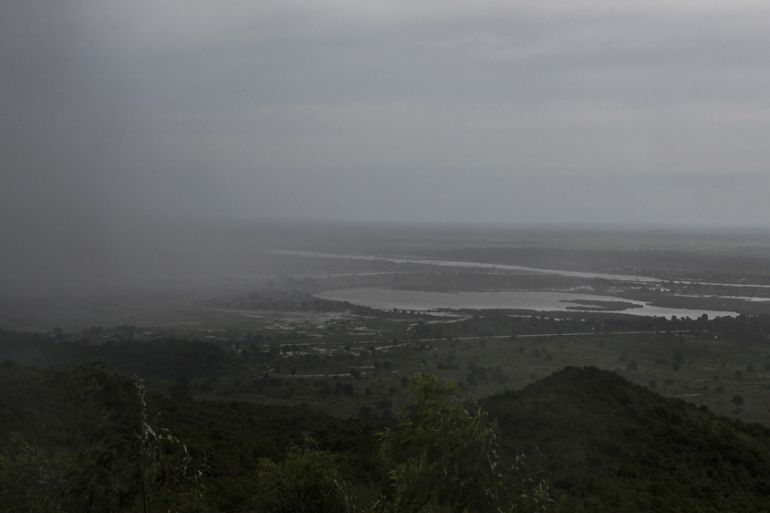Cyclone Idai hits Zimbabwe, at least 31 people dead
The storm which brought floodwater and widespread destruction to Mozambique and Malawi has reached Zimbabwe.

At least 31 people have been killed and dozens are missing in parts of eastern Zimbabwe after the country was hit by tropical cyclone Idai which lashed neighbouring Mozambique and Malawi, the government said.
Cyclone Idai has affected more than 1.5 million people in the three southern African countries, according to the United Nations and government officials.
Keep reading
list of 4 itemsChina evacuates over 100,000 as heavy rain continues to lash south
Asia bears biggest climate-change brunt amid extreme weather: WMO
Photos: Highest-level rainstorm warning issued in south China’s Guangdong
Homes, schools, businesses, hospitals and police stations have been destroyed. Roads have been washed away and thousands are stranded by heavy flooding.
Zimbabwe’s Ministry of Information said on Saturday that the deaths were mainly from Chimanimani East, including two students, while at least 40 other people have been injured.
It added that the Zimbabwean national army was leading rescue efforts to airlift students from a damaged school and others trapped by the storm.
A group of people, who fled their homes, was “marooned” on top of a mountain waiting to be rescued, but strong winds were hampering helicopter flights, the ministry said.
Joshua Sacco, a member of parliament in Chimanimani district, said at least 25 homes were swept away following a mudslide at Ngangu township.
“There were people inside,” he told AFP news agency. “The information we have so far is that over 100 people are missing.”
In a Twitter post, Jacob Mafume, spokesman for Zimbabwe’s main opposition Movement for Democratic Change party, warned that there was a “serious humanitarian crisis” unfolding in eastern Zimbabwe districts.
Serious humanitarian crisis unfolding in chimanimani chipinge most of our structures comms are down.We need state intervention on a massive scale to avoid biblical disaster ,homes bridges being washed away lives in danger @hwendec @daddyhop@kwirirayi @nelsonchamisa @mdczimbabwe pic.twitter.com/QSVEe7yiG7
— Mayor of Harare, Jacob Mafume (@JMafume) March 16, 2019
In Mozambique, where Idai made landfall on Thursday, at least 19 people died and about 70 were severely injured. The storm hit with wind gusts of about 160 kilometres per hour, causing ocean waves of up to nine metres high.
Al Jazeera’s senior meteorologist, Steff Gaulter said a lot more rain was expected over the next days.
“Eastern Zimbabwe reported 400 millimetres of rain over the last 24 hours and there’s a lot more torrential rain to come for central Mozambique and neighbouring Zimbabwe,” Gaulter said.
“Some models are estimating as much as 900mm in the next three days. This would cause immense flooding and trigger further landslides, and the water would then have to drain into the sea. This would mean further flooding would occur as the water surges down the rivers.”
Luis Fonseca, a journalist at Lusa News Agency, told Al Jazeera that the cyclone would continue to create trouble.
“The problem now is that the rivers are likely to flood all the areas around, and this will cause even more damage to all these families which have [already] lost their houses.
“Now they risk losing their harvest and food insecurity is the next big risk in all over this area,” Fonseca explained.
Local officials in Mozambique said that heavy rains earlier in the week, before the cyclone struck, had already claimed another 66 lives, injured scores and displaced 17,000 people.
When the cyclone hit Mozambique, authorities were forced to close the international airport in the port city of Beira after the air traffic control tower, the navigation systems and the runways were damaged by the storm.
An official at the National Institute of Disaster Management (NIDM) of Mozambique told AFP on Friday “there is extreme havoc”.
“Some runway lights were damaged, the navigation system is damaged, the control tower antennas and the control tower itself are all damaged.”
“The runway is full of obstacles and parked aircraft are damaged.”
The storm also brought heavy downpours in neighbouring Malawi this week, affecting almost a million people and claiming 56 lives, according to the latest government toll.
South Africa‘s military has sent in aircraft and 10 medical personnel to help in Mozambique and Malawi, it said in a statement on Saturday.